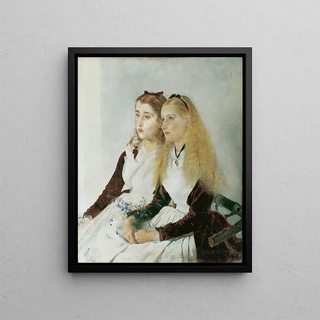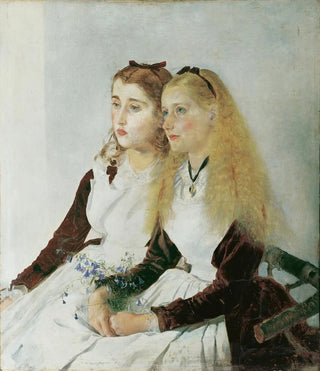Art print | The artist's nieces, Elisabeth and Maja - Anton Romako Source: Reproduction | Les nièces de l'artiste, Elisabeth et Maja - Anton Romako


View from behind

Frame (optional)
In the vast panorama of art history, certain works stand out for their ability to capture the very essence of human relationships. The art print Les nièces de l'artiste, Elisabeth et Maja - Anton Romako is a perfect example. This canvas, evoking a gentle and warm intimacy, transports us into the artist's personal universe, while offering a fascinating glimpse into the lives of two young girls. Through the lens of painting, Romako manages to immortalize a fleeting moment, a simple interaction between two beings who, through their presence, tell a much broader story.
Style and uniqueness of the work
Anton Romako's style is characterized by delicacy of lines and mastery of colors that subtly depict human emotions. In this piece, the faces of Elisabeth and Maja are modeled with particular attention, each expression revealing a part of their personality. The light, subtly orchestrated, plays a fundamental role, illuminating the faces and creating an almost palpable atmosphere. The background, though blurred, helps to emphasize the intimacy of the moment, allowing the viewer to focus on the two nieces. This stylistic approach, blending realism and impressionism, makes Romako a unique artist, capable of transcending the simple portrait to offer a true emotional experience.
The artist and his influence
Anton Romako, born in 1832 in Austria, established himself as a major figure of his time. His artistic journey, marked by diverse encounters and influences, allowed him to develop a unique style, combining tradition and modernity. Romako was particularly influenced by the great masters of the past, while incorporating contemporary elements that are his own. His work, often centered on portraits and scenes of daily life, reveals a keen sensitivity to the nuances of human relationships. Through his works, he invites the viewer to contemplate not only external beauty but also the depth of the emotions that animate the subjects. This ability to establish a connection between art and everyday life made him a pioneer, whose influence is still felt in the art world.

Matte finish

View from behind

Frame (optional)
In the vast panorama of art history, certain works stand out for their ability to capture the very essence of human relationships. The art print Les nièces de l'artiste, Elisabeth et Maja - Anton Romako is a perfect example. This canvas, evoking a gentle and warm intimacy, transports us into the artist's personal universe, while offering a fascinating glimpse into the lives of two young girls. Through the lens of painting, Romako manages to immortalize a fleeting moment, a simple interaction between two beings who, through their presence, tell a much broader story.
Style and uniqueness of the work
Anton Romako's style is characterized by delicacy of lines and mastery of colors that subtly depict human emotions. In this piece, the faces of Elisabeth and Maja are modeled with particular attention, each expression revealing a part of their personality. The light, subtly orchestrated, plays a fundamental role, illuminating the faces and creating an almost palpable atmosphere. The background, though blurred, helps to emphasize the intimacy of the moment, allowing the viewer to focus on the two nieces. This stylistic approach, blending realism and impressionism, makes Romako a unique artist, capable of transcending the simple portrait to offer a true emotional experience.
The artist and his influence
Anton Romako, born in 1832 in Austria, established himself as a major figure of his time. His artistic journey, marked by diverse encounters and influences, allowed him to develop a unique style, combining tradition and modernity. Romako was particularly influenced by the great masters of the past, while incorporating contemporary elements that are his own. His work, often centered on portraits and scenes of daily life, reveals a keen sensitivity to the nuances of human relationships. Through his works, he invites the viewer to contemplate not only external beauty but also the depth of the emotions that animate the subjects. This ability to establish a connection between art and everyday life made him a pioneer, whose influence is still felt in the art world.






